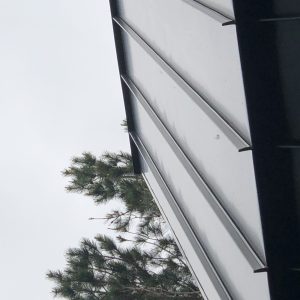Hi Fine Homebuilding community, after many recommendations, I’m posting some issues here that we’ve experienced on a residential project in hopes to get some feedback.
Heres the scenario:
– clients wanted standing seam roof
– architect spec’d 24 ga flat panel w/ 1.5” seam on nailers o/ membrane etc
– roofing sub insisted on installing directly to membrane (we were fine with that)
– roofing sub insisted we sign a waiver saying that flat panel standing seam may oil can.- which was understandable. But followed it up saying there was very little chance of any given the flatness and simplicity of the job.
– roofers installed it. Many of them seemed very unqualified. In fact some of them said they had never installed standing seam before.
The roofing is now done and I’ve never seen flat standing seam panel look so bad. It’s almost like the panels were not screwed down correctly and warped in a uniform manner. Nearly every single panel is warped in 3 or 4 places.
What do do you think? Check out the photos. Is this normal oil canning or is it poor workmanship? We’re a bit unfamiliar with what our expectations should be…
Thanks everyone
Ps – looked for previous posts regarding SS install but didn’t find any that helped. If you know of some existing conversations please post! Ty





















Replies
I've only done one (my own) and got trained at the factory by the manager for a few hours (had a lot of custom skylights so needed technical guidance for all the trim and flashing), but I had success (and 26ga. 25' long panels and I've had zero oil-canning). First warning from manager: don't overdrive the screws and don't use an impact driver. The 25' panels will expand and contract nearly an inch from morning shade to full afternoon sun, and the screws have to let the panel slip (the flange will have slots, not simply a hole for the screw). He said biggest cause of oil-canning is when there are a few screws that get too snug and the panel can't move from that point. My manufacturer also required both an ice/water shield, and on top of that, a synthetic underlayment, as a slip sheet. Due to the contraction/expansion, the metal will move a lot. They don't want that moving directly on the ice and water shield lest it rub through it eventually in any high spots. The synthetic underlayment adds an extra buffer.
Thanks for the feedback. Yes someone else had mentioned that over-tightening the screws will cause warping. Interesting to hear about the slip sheet - i'll check into that.
That’s looks like serious oil canning alright. How straight was the roof deck? Wavy roof decks require shimming under the clips for a straight panel. If you fasten the panels in a bind, they will oil can like crazy. That’s what it looks like to me. It could be screwed down too tight also. There are a lot of different clip styles and some are ok to screw down tight as they leave enough wiggle room for the panel. Some are not. Which style do you have? As a side rant, any roof that you have to put 100% ice and water on is a failure. It’s never necessary. If you think you have to install that way you are either using the wrong product for the job or you don’t have confidence in your installation details. I’ve never seen a product so over used. I can’t imagine why that would be specified on a standing seam roof. I’ve removed 100 year old Follansbee tin roofs that were installed directly over the sheathing and they never leaked. That being said, standing seam requires all ice and water to be covered with synthetic underlayment as a slip sheet. All underlayments for standing seam have to be rated as Hi-temp also. You can’t use regular roofing underlayment. One killer trick we use to reduce oil canning is to run 1/2” foam backer rod down the center of each panel on the roof deck. It gives each panel a slight crown and reduces oil canning considerably.
also, my manufacturer required a waiver of warranty related to oil canning if the width between seams was more than 16". I've seen other manufacturers recommend using a foam backer rod underneath the middle of the panel, to create a slight camber (raising the middle) which helps keep the oil canning over to the edges where it's less noticeable. I've been fortunate not to have any (in spite of not really having any direct sight lines to this roof anyway given that we live in a woods). Good luck
Trying to force panels to a straight line when the one you're butting to is crooked will make those wrinkles. If you take a panel loose and it springs out you'll know if that's the problem. I would use a dry line on one in the middle and see if the joint is perfectly straight.